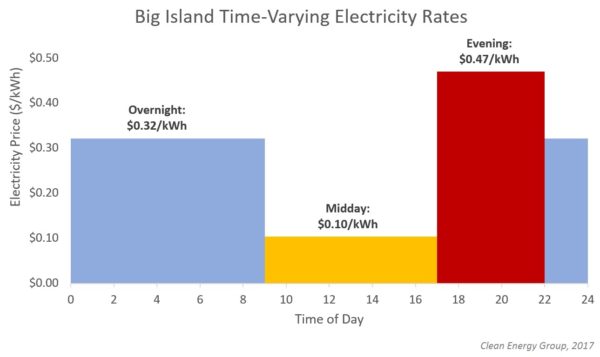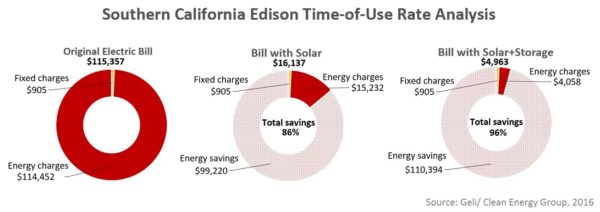January 20, 2017
Time-of-Use Means It’s Time for Storage
By Seth Mullendore
Last September, the Hawaii Public Utilities Commission approved a pilot program in which residential utility customers pay a drastically different price for electricity depending on when they’re using it. This type of rate design, known as time-of-use (TOU) pricing, is nothing new.
But what is new is that the rate structure could have profound implications for the value of solar systems on the islands, and energy storage might be needed to keep those systems economic. In that story is a lesson for the country and the future of solar.
Many utilities have TOU programs that charge higher rates for electricity used during peak periods and lower rates during off-peak periods. The twist is that under Hawaii’s TOU pilot program the lowest electricity prices occur during the middle of the day – when solar production is at its peak – and ramp up in the evening. Low daytime rates and high evening electricity prices will translate into significantly lower energy savings for solar customers that don’t have a way to store energy generated during the day.
Anyone wanting a glimpse of the future path of solar, and how it could affect utility rate design, in the U.S. can just take look at what’s going on in Hawaii. As an island state, Hawaii faces some electricity constraints that other states may not have to contend with, but it still serves as a good indicator for where other leading solar states may be headed soon.
With nearly one out of every five costumers sporting a rooftop solar system (very few of which currently have storage), Hawaiian Electric Companies has to deal with a lot of solar pouring onto the grid during the middle of the day. In 2015, Hawaii became the first state to dismantle its solar net energy metering program. Instead, the state replaced net metering with two options for solar customers: a grid-supply option, which pays utility customers about half the retail rate for exported energy, and a self-supply option, which includes storage and only allows very limited, uncompensated export of solar energy.
Now, with the introduction of TOU rates and peak evening pricing, Hawaii is taking the next step in its renewable energy evolution. By charging less for electricity during peak solar hours and more during the evening when net demand is on the rise, the utility is aiming to encourage customers to use more electricity during the day when low-cost solar energy is plentiful.
Under this TOU pilot program, electricity prices can jump more than four times higher as the sun begins to set in Hawaii. The price increases from a daytime low of 10 cents per kilowatt-hour to 47 cents per kilowatt-hour at 5pm for residents of the Big Island. Without energy storage, nearly all of the solar generated by residential solar systems throughout the day goes towards offsetting the lowest priced electricity during the daytime hours, severely impacting the economic benefits of solar for Hawaiian customers.
With less value for energy produced during the day, solar customers without storage are unlikely to opt into this new rate. However, both the Big Island and Maui have already reached the mandated cap on accepting grid-supply customers. This means that any new solar customers are likely going to be looking at both solar and storage under the self-supply option.
The realty is simple: storage changes the value proposition for these solar customers. Instead of solar energy merely offsetting 10 cents per kilowatt-hour during the day, it can be stored until the evening when it’s worth much more to both the customer and the utility. Energy storage allows solar customers to maximize the value of their system and fully capture the benefits of solar.
With storage costs on a rapid decline, combining solar with storage will increasingly make sense for Hawaii’s utility customers. Even households without solar may begin to look into investing in storage as a way to lower energy expenses.
Hawaii is well ahead of other states in rooftop solar penetration, but it’s not the only state with residential TOU rates. California is already well on its way to implementing TOU rates for all of its solar customers. Under the state’s updated net metering regulations (NEM 2.0), solar customers will be transitioned to TOU rates as the state’s investor-owned utilities hit their initial net metering caps. San Diego Gas & Electric already hit its 5 percent peak load cap back in July of last year. In Colorado, Xcel Energy is also introducing TOU rates for residential customers under a compromise deal with solar and consumer interest groups.
In support of a nonprofit coalition proposal for implementation of California’s Multifamily Affordable Housing Solar Roofs Program, Clean Energy Group worked with the energy software company Geli to assess the value of solar and storage under TOU rates. The analysis (shown below for an affordable housing building with 80 units) found that adding storage to a solar system in California could boost savings by ten percent for affordable housing residents based on existing TOU rate structures. The total savings translated into about a 3-year payback for Southern California Edison customers installing a solar+storage system.
The difference between summer peak and off-peak electricity rates in Southern California Edison’s residential TOU tariff is similar to the Big Island. Summer peak is 48 cents per kilowatt-hour while the off-peak rate is 12 cents per kilowatt-hour.
The difference is that California still has comparably low levels of solar penetration, so the high-priced peak period occurs during the day when solar is still producing. As California reaches higher levels of solar deployment, the timing of peak electricity pricing will inevitably shift to high demand periods that occur later in the day.
The implications of this shift is particularly important for low-income households, who devote a disproportionately high percentage of their income towards energy expenses. It is a sad irony that the value proposition for residential solar is beginning to erode just as the country is finally getting serious about bringing solar benefits to low- and moderate-income families. That is why it is critical that storage be considered in any new solar initiative like the Multifamily Affordable Housing Solar Roofs Program. Without storage, low-income solar customers will be left vulnerable to looming changes in net metering policies and utility rates design.
Hawaii’s pilot program is currently limited to 5,000 customers. Whether or not this type of solar off-peak rate design will catch-on in Hawaii or spread to other states still remains to be seen. But with U.S. solar installations at one-million systems and climbing, it’s likely to be just a matter of time before some of Hawaii’s solar challenges reach the mainland and more utilities begin looking into similar electricity pricing structures.
As utilities increasingly show interest in alternative rate structures like TOU pricing, particularly for solar customers, it won’t be long before the U.S. realizes SolarCity CEO Lyndon Rive’s prediction of “hundreds of thousands, if not millions, of solar systems combined with storage.”
***
This blog post was also published on Renewable Energy World.
















